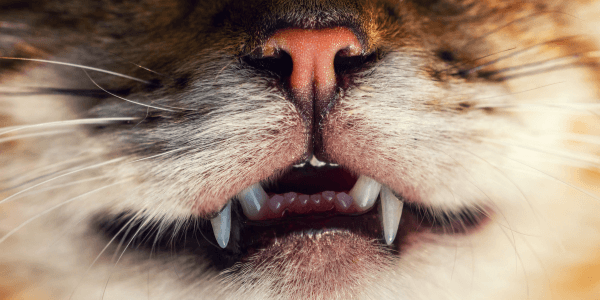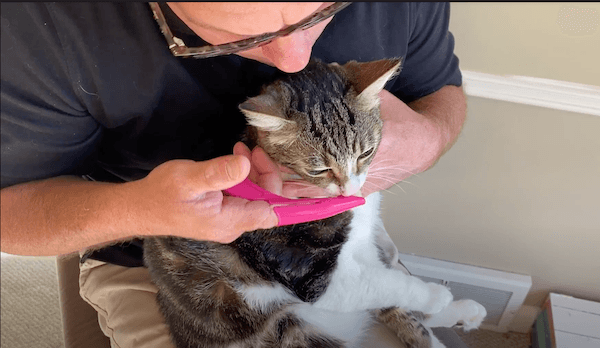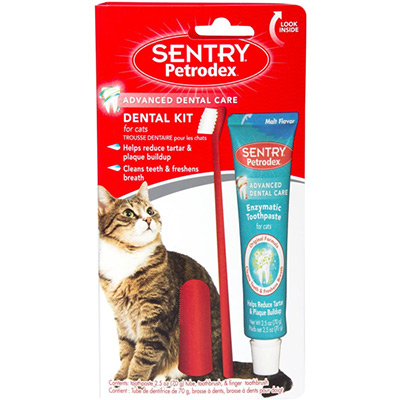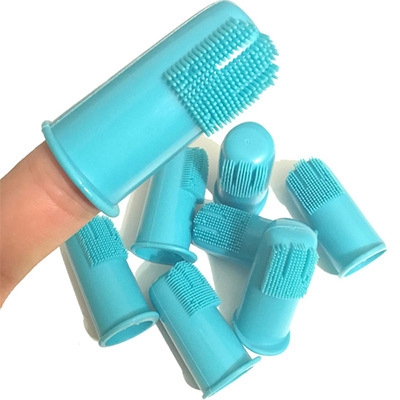
Alright, let’s be honest. Brushing your cat’s teeth probably sounds as appealing as giving your cat a bath. Both situations have the potential to lead to, not only a stressed-out feline, but an equally frazzled human.
Despite all of this, as a responsible cat lover, you know — just like people — good feline dental health leads to better overall health! Good dental hygiene can help avoid serious dental disease, and several other issues creating bad cat breath.
Skip to Section:
Introducing Your Cat to the ToothbrushBrushing Your Cat's Teeth for the First Time
Why Brushing Improves Overall Health
What Causes a Cat's Bad Breath
Don't 'Brush-off' Your Cat's Teeth
If you're feeling like you're getting into the ballgame late, don't worry! That’s really the genesis to this article. Although, I tried to introduce both our family cats to pretty much everything, that was not the case when it came to brushing their teeth.
The bright spot is you don’t have to brush their teeth every day (I will get into their schedule further down). I have two young kids, so you can probably imagine adding in two cats and myself (my wife is self-sufficient), is a lot of daily dental responsibility!
How to Prepare Your Cat for Brushing Their Teeth
For most of us, the thought of putting on a finger-fitted toothbrush for a cat, or just using a typical pet toothbrush, and then sticking our hands in or near their mouth, seems like it will end in either getting bit or scratched. This can happen! And often does if you don't ease your cat into it.
It's true that the earlier you start teaching your cat to enjoy getting their teeth brushed, the easier it will be. The older they are when you start may prove challenging, but with consistency, it will be worth your while. I know this because I didn't start brushing our cats' teeth until they were around three-years-old.
- Introduce teeth brushing early (But if you haven't, it may just take a little more time)
- Be consistent
- Be patient
- Create a safe space
Remember, when you are introducing your cat to all things dental, be patient and thoughtful. It’s not natural for a cat to have your finger or a piece of plastic with bristles placed inside their mouth, so use their curiosity to gain their trust.
Equally important, is to find a place that creates a sense of calm. Whether you do it with them sitting on a blanket, towel, on a table, or you choose to hold them while brushing — it’s in your best interest to create a safe environment that can be replicated each time.
Introducing Your Cat to the Toothbrush
Although I prefer a finger-fitted brush (because of the ease while holding them), there are a number of highly recommended standard pet toothbrushes that you may feel more comfortable with. Let them explore the toothbrush but do not introduce the toothpaste yet.
The point of this stage is to simply introduce your cat to the toothbrush.
Pro Tip: Try not to use a toothbrush with too large of a head. You may want to try one of these options, which we also recommend:
-
A toddler training toothbrush — they are small, soft, and usually pretty cheap. They're also comfortable for small mouths.
-
Gauze pads! Open the gauze pad and wrap it around your finger. Then gently rub your cat's teeth and gums. (I do not advise this method for cats that bite when something is in their mouth)
-
You can purchase pet dental wipes that work similarly to the gauze method but come with their own cleaning agents.
-
A cotton tip applicator or Q-Tip — not the fluffy soft kind, but a stiff sturdier swab that won't come apart in your cat's mouth. They are small and provide enough roughness to easily remove soft plaque. Just be very careful not to be too rough.
-
For cats who resist all attempts to brush their teeth, you can dip the Q-tip in canned tuna juice or pure chicken broth (no garlic/onion other seasoning added) prior to using. Just be sure to throw the applicator away so that your cat isn't tempted to eat it!

Once you feel like your cat is at ease with the toothbrush being around their face, you will want to put the toothbrush to the side.
Wait, what? I know it sounds counterintuitive, but before you put the toothbrush in their mouth, you will initially want them to feel comfortable having your finger act as the toothbrush. I know this doesn’t sound like a good idea in theory, but trust me, it works.
- Use your index finger to start massaging their mouth
- Gently slide your finger inside their lips
- Pay attention to your cat's mood
You want to start with your index finger and gently massage the side of their mouth at the oral commissures. That’s just Latin for where two objects join – and in this case, it’s the corner of the cat’s mouth where their upper and lower lips meet. That’s your way in!
You will want to gently massage the area until it seems reasonable to slowly slide your finger in their mouth. You’re not going to shove your finger in there, but rather gently start rubbing the sides of their canines (those fang-like teeth). This will be the foundation for you to eventually move onto the toothbrush.
During this process, always pay attention to your cat. Don’t ignore signs of agitation or discomfort; it will only create a negative association with the experience. If you need to "put a pin in it" and come back to the process later, then that’s what you should do. In all transparency, not all cats are open to having their teeth cleaned. So, if your cat’s personality is defiant, give it time. Remember, repetition is the mother of all learning.
If your cat is comfortable with you rubbing around their mouth, you can grab your toothbrush again. You still have no need for toothpaste at this point.
- Start rubbing the toothbrush around your cat's mouth gently.
- Gently transition onto your cat's front canines.
- Use light and gentle strokes.
- Limit time to the comfort level of your cat.
- Reward them with their favorite treats.
Gently use the same tactic you would with your finger, but now insert the toothbrush. You are not necessarily looking to start brushing their teeth — this is the step where we want them to be comfortable with the toothbrush in their mouth. When you do begin to brush their teeth, it’s important to note that how you brush your teeth and how you brush your cat’s teeth is completely different. You need to use slow and light strokes.
Brushing Your Cat's Teeth for the First Time
This is the step where you will want to introduce toothpaste. There are various brush options and toothpaste for cats that you can find online. I prefer Petrodex Enzymatic Toothpaste because my cats like the taste.
It also comes as a kit with an angled brush and finger brush. However, you may want to try different kinds of toothpaste to find the one your cat likes most and order a separate toothbrush. Below is another option we recommend.
- Start with a small amount of toothpaste on your finger
- Let your cat taste initially
- Use your finger to rub around inside their mouth
You will want to put a little toothpaste on your finger first and let your cat taste it. It’s actually fun. Many times, the toothpaste tastes like a treat for cats, so the task doesn't seem so daunting!
Then you will want to put a small amount on the toothbrush and start with their front canines. When you are brushing, it’s best to brush where the gum tissue meets the tooth.
How Long Do You Brush a Cat's Teeth?
Let me just say that less is more! You only need to give a few strokes with the toothbrush. You may need or want to add more toothpaste as you make your way through their mouth.
- Put a small amount of toothpaste on the toothbrush
- Brush where the gum meets the tooth
- Start with front canines
- Move to back molars
- You don't need to brush for very long
I prefer to do one side at a time. I start with the canines and then move back to the molars. And I repeat the process on the other side. The whole process should only take you a couple of minutes at most.
How Often Should You Brush Your Cat's Teeth?
If you can clean your cat’s teeth daily, you are setting the bar. But, even if you are able to brush your cat’s teeth a couple of times a week, you are probably still ahead of the curve. So, let that be your goal!
Don't be discouraged if you are periodically brushing your cat's teeth and feel you're not doing enough. Again, brushing your cat's teeth does not require a lot of time, so try to increase the number of times you brush each week, until you have a schedule that works for you!
Why Brushing Your Cat's Teeth Helps Their Overall Health
Proper care of our cat's teeth helps prevent a myriad of health issues and dental disease. If you find that your cat adjusts well to home tooth brushings, it's still important to still have their teeth checked and cleaned annually at your veterinarian's office.
Some cats, particularly those with previous dental disease or stomatitis, underlying health conditions like kidney disease or diabetes, and senior cats, should have their mouths checked as part of an overall exam every six months.
If your cat’s gums are already red and sore, they are missing teeth, unable to chew hard food, or have any drooling/pawing at the mouth, refrain from brushing their teeth at home until your veterinarian has given you the okay to do so. They may need a professional cleaning first, and then you can maintain that clean with brushing at home.
What Causes a Cat to Have Bad Breath
Potential causes of bad breath in cats and dogs, other than dental issues, include:
- Kidney disease
- Liver disease
- Lung disease
- Foreign bodies stuck in the mouth (sticks are a very common culprit for dogs!)
- Tumors within the mouth or throat (squamous cell carcinomas are both a painful and aggressive tumor type that can occur in the mouths of both cats and dogs)
- Ulcers of the tongue or other tissues within the mouth
- Out of control diabetes (a condition called ketosis)
- And several others
So, while bad teeth and periodontal disease do cause bad breath — and are, in fact, the most common causes of bad breath in cats and dogs — they are not the ONLY cause of bad breath.
Watch out for worsening bad cat breath! If a change occurs, have it checked out by your veterinarian right away.
Why is this important? Unfortunately, many pet owners assume that bad breath is only caused by an issue with their teeth (which is not the case, as explained above). And because of that, there can be some hesitancy by the owner that they will have to put their pet under anesthesia. We recommend before making any decisions about care, if you notice your pet's increasing bad breath (or any dental issues), contact your veterinarian to discuss options.
Hopefully, this tutorial is helpful for you when starting and maintaining your cat’s dental health. Brushing your cat's teeth can be a great bonding experience for you and your cat. And beyond the time it takes to get your cat used to the process, regular weekly cleanings will take very little time. Of course, if your cat is not a fan of regular brushings, make sure that, at the very least, you have their teeth professionally cleaned under anesthesia once a year.






